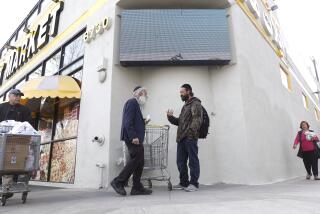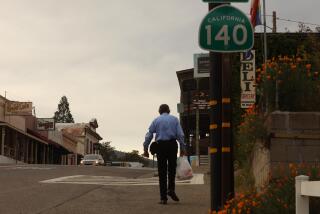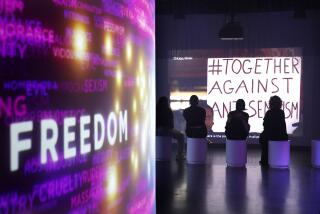Seniors See Busy Street in Unique Perspective
Along the busy shopping area of Fairfax Avenue just north of Beverly Boulevard, the rush of black-clad teenagers, multi-pierced rock ‘n’ rollers, homeless wanderers and Jewish yuppies all but eclipses the street’s slowest-moving pedestrians.
These are the elderly residents of the Shalom Retirement Hotel, one street over from Fairfax, the most overlooked and most enduring presence on this trendy street.
Under poofs of white hair and sometimes using metal walkers, they are the avenue’s observers, historians and often its biggest boosters. Their observation post, the Shalom, gives them small hotel balconies, decorated with large, red letters spelling out the home’s name.
For the elderly Jews who live here, being mere extras in the Fairfax scene is rarely an indignity; their ability to continue walking the avenue is a way of reclaiming the urban existence that was so much a part of their lives in this and other Los Angeles neighborhoods.
“I think Fairfax is still pretty good considering the changes we’ve had,” said Ida Skayan, a 40-year-resident of the area who lives at Shalom and will turn 90 next month. “For the older folks, it was so different years ago. But maybe we looked at it with younger eyes.”
Through older eyes, the view of Fairfax from Shalom is as exciting as it is frightening.
The nearby $2 movie theater, on Beverly, is a popular spot for those who can walk the sometimes achingly long half-block.
Meals at the much beloved Canter’s deli, Eat A Pita or Damiano’s pizza are hard-earned treats for some who wish to vary the dining room fare and save their energy for the trip around the block and up the avenue.
The stores offer time-tested window shopping, with a variety of religious items, Jewish literature and music as well as sensible clothing that is perfect for senior citizens.
But more than food and gifts, walking along Fairfax is a way of staying involved.
The people-watching is unmatched. Ida Skayan said she enjoys watching the younger ones, noting which cafes and restaurants seem to be in vogue.
“I’m not afraid,” she says. “They treat the old people pretty nice.”
Some residents are eager to venture out by themselves to the fruit markets, kosher butchers and Jewish curio stores that are the hallmark of the area. Long having abandoned their cars and their haste, they experience a new appreciation of the old neighborhood.
“Oh, I’m having fun!” said Edith Ferrara, 86, who lives in Shalom with her husband, Alfred. “I love the stores and the people in the streets. Now I walk everywhere.”
Change brings complexity. “The banks take on different names,” Skayan says. “They combine, and you don’t know which is which.”
Eighty-year-old Ruth Ruben’s route to her acting workshop takes her by “where the old shoe store used to be.”
Others wait for children or grandchildren to guide their way through the bustle, enjoying the time--and protection--of family.
Some, perched in chairs that line the front hallway and upstairs balconies, just watch, listen and imagine the busy avenue outside, too infirm or uncertain to venture onto the street.
*
The Shalom, with a board-and-care counterpart across the street for more dependent senior citizens, was built about 30 years ago by the Goldsteins, Lithuanian immigrants and Holocaust survivors. The family had three boys, two of whom were old enough to remember the months hiding in the forests and country farms after running away from their ghetto prison. In a village of 200 Jews, the family was among only eight who survived.
After years in a German displaced persons’ camp, the family joined a cousin in Los Angeles and soon began taking in elderly people who had nowhere else to go.
Eventually, the Goldsteins built the Shalom, both a temporary and long-term home for those who observed Jewxish dietary laws and wanted to maintain some independence.
Today two of the brothers, Alan and David, run the hotel. One employee muses that their difficult childhoods connect them to the senior citizens in a way that other, younger adults could never share.
The Shalom remains a place for people of modest means. Rooms, which include activities, maid service and three meals a day, cost about $900 per month.
Residents meet in the sunny yellow “coffee shop”--a kitchenette with a soda machine, coffee, milk and juice. They take exercise classes in the immaculate second-floor common area, decorated in bright turquoise, olive green and orange. They play cards in the same spot on the third floor and are treated to films, lectures and visits by beauticians.
The 100 people who live there hail from as many countries as there are Jews, rendering meal and group times a melodious blend of different sounds.
Many speak Yiddish. Others still remember their Polish, Portuguese, Spanish, German and Quebecois. Newer Russian immigrants live alongside those who remember none of that language, having moved here as children. Some, born here, have never spoken anything but English.
There are pessimists among the group who are content to live out their days just off the main drag, never venturing onto Fairfax.
But for those who make it out, the effort is worth it, Ruth Ruben says.
Ruben and her neighbors are the ones who shuffle onto the street in the morning when the partied-out 20-year-olds are sauntering off, even if not many people notice.
“The shops and the people and the Farmers Market--to me it’s still as exciting as the day I saw it,” she says.
More to Read
Sign up for The Wild
We’ll help you find the best places to hike, bike and run, as well as the perfect silent spots for meditation and yoga.
You may occasionally receive promotional content from the Los Angeles Times.






